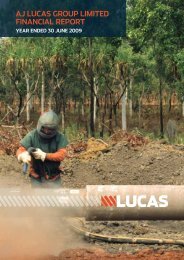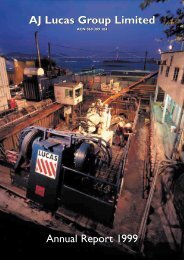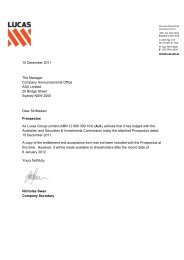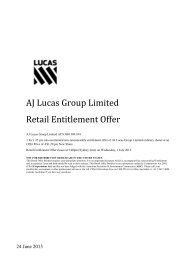AJ Lucas Group annual report 2007-08
AJ Lucas Group annual report 2007-08
AJ Lucas Group annual report 2007-08
Create successful ePaper yourself
Turn your PDF publications into a flip-book with our unique Google optimized e-Paper software.
Risk management policies are established to identify and analyse the risks faced by the Company and <strong>Group</strong>, to set appropriate risk limits and<br />
controls, and to monitor risks and adherence to limits. Risk management policies and systems are reviewed regularly to reflect changes in market<br />
conditions and the Company’s and <strong>Group</strong>’s activities. The Company and <strong>Group</strong>, through their training and management standards and procedures, aim<br />
to develop a disciplined and constructive control environment in which all employees understand their roles and obligations.<br />
The Audit Committee oversees how management monitors compliance with the Company’s and <strong>Group</strong>’s risk management policies and procedures<br />
and reviews the adequacy of the risk management framework in relation to the risks faced by the Company and <strong>Group</strong>.<br />
Credit risk<br />
Credit risk is the risk of financial loss to the <strong>Group</strong> if a customer or the counterparty to a financial instrument fails to meet its contractual obligations,<br />
and arises principally from the <strong>Group</strong>’s receivables from customers. For the Company, it arises principally from receivables due from subsidiaries. The<br />
maximum exposure to credit risk is the carrying amount of the financial assets.<br />
Trade and other receivables: The Company’s and <strong>Group</strong>’s exposure to credit risk is influenced mainly by the individual characteristics of<br />
each customer. The <strong>Group</strong>’s customer base consists of mainly government, semi-government and major public company customers. The demographics of<br />
the <strong>Group</strong>’s customer base, including the default risk of the industry and location in which the customers operate, has less of an influence on credit risk.<br />
New customers are analysed individually for creditworthiness, taking into account credit ratings where available, financial position, past experience<br />
and other factors. This includes all major contracts and tenders approved by the <strong>Group</strong> Tender Committee.<br />
In monitoring customer credit risk, customers are grouped by business segment, and then by their debtor aging profile. Monitoring of receivable<br />
balances on an ongoing basis minimises the exposure to bad debts. There are no significant concentrations of credit risk within the <strong>Group</strong>.<br />
A provision for impairment is recognised when there is objective evidence that a individual trade receivable is impaired.<br />
Exposure to credit risk: The carrying amount of financial assets represents the maximum credit exposure. The maximum exposure to credit<br />
risk at the <strong>report</strong>ing date was:<br />
Consolidated<br />
Company<br />
20<strong>08</strong> <strong>2007</strong> 20<strong>08</strong> <strong>2007</strong><br />
$’000 $’000 $’000 $’000<br />
Trade and other receivables 56,912 28,262 6,064 4,189<br />
Bank balances 16,612 18,222 5,519 13,512<br />
Loans to controlled entities — — 49,889 31,795<br />
73,524 46,484 61,472 49,496<br />
Maximum exposure to credit risk for trade and other receivables at the <strong>report</strong>ing date<br />
by business segment was:<br />
Drilling 15,853 13,515 — —<br />
Pipelines 25,711 3,684 — —<br />
Construction and infrastructure 8,594 5,756 — —<br />
Unallocated 6,754 5,307 6,064 4,189<br />
56,912 28,262 6,064 4,189<br />
Impairment losses: The ageing of the <strong>Group</strong> and Company’s trade receivables at the <strong>report</strong>ing date was:<br />
Gross<br />
20<strong>08</strong><br />
$’000<br />
Impairment<br />
20<strong>08</strong><br />
$’000<br />
Consolidated<br />
Gross<br />
<strong>2007</strong><br />
$’000<br />
Impairment<br />
<strong>2007</strong><br />
$’000<br />
The ageing of trade receivables at the <strong>report</strong>ing date was:<br />
Not past due 38,135 — 14,463 —<br />
Past due up to 30 days 7,826 — 4,094 —<br />
Past due 31 to 120 days 2,953 — 4,248 —<br />
Past due 121 days to one year 1,253 (9) 156 (7)<br />
More than one year 7,187 (7,187) 7,189 (7,189)<br />
57,354 (7,196) 30,150 (7,196)<br />
There was nil movement in the allowance for impairment in respect of trade receivables during the year for the <strong>Group</strong>, as such the balance as at<br />
30 June 20<strong>08</strong> was $7,196,000 (<strong>2007</strong>: $7,196,000).<br />
a year of milestones 55














